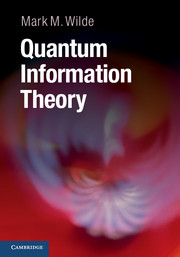Book contents
- Frontmatter
- Contents
- How To Use This Book
- Acknowledgments
- Part I Introduction
- Part II The Quantum Theory
- 3 The Noiseless Quantum Theory
- 4 The Noisy Quantum Theory
- 5 The Purified Quantum Theory
- Part III Unit Quantum Protocols
- Part IV Tools of Quantum Shannon Theory
- Part V Noiseless Quantum Shannon Theory
- Part VI Noisy Quantum Shannon Theory
- Appendix A Miscellaneous Mathematics
- Appendix B Monotonicity of Quantum Relative Entropy
- References
- Index
5 - The Purified Quantum Theory
from Part II - The Quantum Theory
Published online by Cambridge University Press: 05 May 2013
- Frontmatter
- Contents
- How To Use This Book
- Acknowledgments
- Part I Introduction
- Part II The Quantum Theory
- 3 The Noiseless Quantum Theory
- 4 The Noisy Quantum Theory
- 5 The Purified Quantum Theory
- Part III Unit Quantum Protocols
- Part IV Tools of Quantum Shannon Theory
- Part V Noiseless Quantum Shannon Theory
- Part VI Noisy Quantum Shannon Theory
- Appendix A Miscellaneous Mathematics
- Appendix B Monotonicity of Quantum Relative Entropy
- References
- Index
Summary
The final chapter of our development of the quantum theory gives perhaps the most powerful viewpoint, by providing a mathematical tool, the purification theorem, which offers a completely different way of thinking about noise in quantum systems. This theorem states that our lack of information about a set of quantum states can be thought of as arising from entanglement with another system to which we do not have access. The system to which we do not have access is known as a purification. In this purified view of the quantum theory, noisy evolution arises from the interaction of a quantum system with its environment. The interaction of a quantum system with its environment leads to correlations between the quantum system and its environment, and this interaction leads to a loss of information because we cannot access the environment. The environment is thus the purification of the output of the noisy quantum channel.
In Chapter 3, we introduced the noiseless quantum theory. The noiseless quantum theory is a useful theory to learn so that we can begin to grasp an intuition for some uniquely quantum behavior, but it is an idealized model of quantum information processing. In Chapter 4, we introduced the noisy quantum theory as a generalization of the noiseless quantum theory. The noisy quantum theory can describe the behavior of imperfect quantum systems that are subject to noise.
- Type
- Chapter
- Information
- Quantum Information Theory , pp. 141 - 156Publisher: Cambridge University PressPrint publication year: 2013

